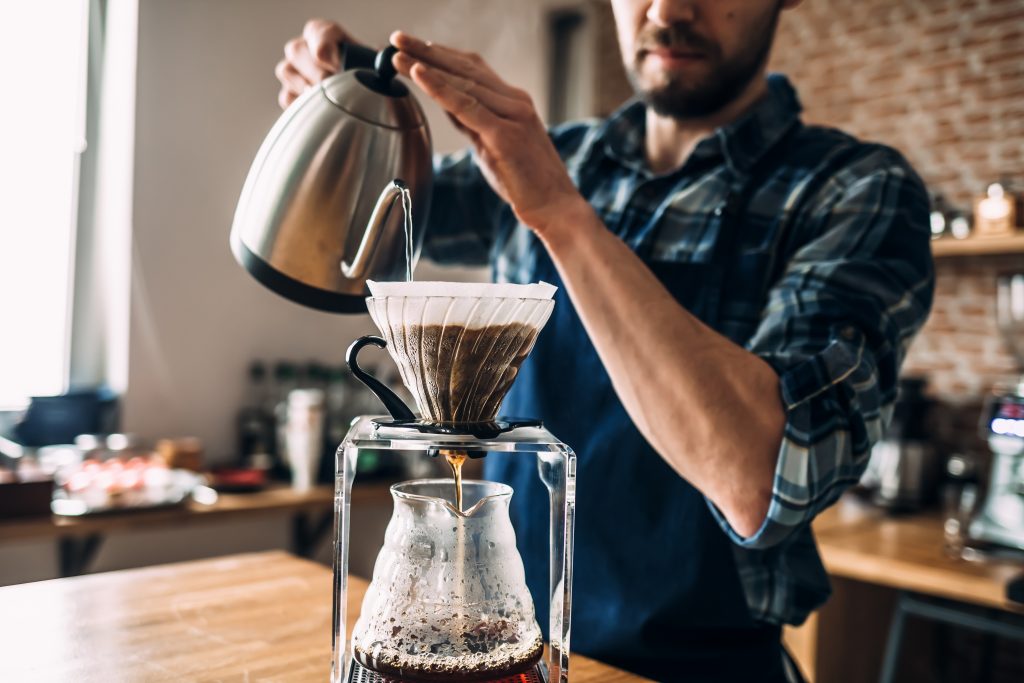If I’m not mistaken; you’re the type of person who loves to experiment with new exciting coffee beans from all over the world.
The world of coffee opens up when you start pairing the right coffee beans with the right brew style. But let’s be honest; pairing COFFEE BEANS with ROAST LEVELS and BREWING TYPES is harder than it sounds.
But you already knew that it was hard – that’s why you’re reading this, right?

If you keep reading this article you’ll become an expert on coffee beans, flavors, and the relationship between the two. This should be enough information for you to make an educated choice when next browsing for beans.
What Taste am I Looking For?
Consider what type of coffee taste are you after:
- A crisp and clean tasting black coffee?
- A strong tasting, dark and rich black coffee? [insert joke about desirable boyfriend here]
- A mellow, acidic black coffee?
- A heavy, musty, chocolatey-tasting black coffee?
- A fruity, florally tasting black coffee
- A subtle-coffee flavored milk based coffee? (e.g. something with overpowering milk taste, such as a cappuccino, latte, flat white etc)
- A strong-coffee flavored milk based coffee? (e.g. something with milk where the coffee flavor still dominates, such as a ristretto, piccolo latte, etc)
Make a mental note of this which will apply in the section below about bean origin.
What Type of Brewer am I Using?
If you already know which brewer you are going to use, just choose the most appropriate type of bean and roast type.
| Brew Style | Recommended Roast | With a Bean From |
| Pressure (Espresso, Moka Pot Or Aeropress) | Medium – Dark Roast | Kenya or Tanzania |
| Steeping (french press or vacuum pot) | Dark Roast/Espresso for an espresso shot | Africa, Indonesia, Central & South America |
| Filtration (e.g. pour over coffee) | Medium, Medium-Dark Roast | Guatemala, Mexico, Costa Rica, Hawaii |
| Cold Brew Coffee | Dark Roast | Nicaragua, Mexico, Brazil, Thailand, Indonesia |
| Boiling (Turkish Or Cowboy) | Medium, Medium-Dark, Dark Roast | Ethiopia, Columbia, Brazil, Costa Rica |
Matching Bean Origin With Brew Method
Where your coffee is grown is the first important factor in how it will taste when you pour it into your cup.
Similar to how certain grapes for wine are grown in specific regions – and how that affects the taste – where your coffee beans come from matters, too.
The plain truth of the matter is that coffee grown in Thailand will taste different than coffee grown in Ethiopia or in Guatemala.
Influences such as altitude, climate (including rainfall and sunlight), and terroir (soil) all make an impact, as do growing, harvesting, and processing methods, which can vary dramatically from one region or culture to the next.

Why does this matter?
Because some flavor profiles are better suited to certain brew methods. For example, pour over coffee creates light, clean, and crisp black coffee; meaning you’ll want to choose a bean with soft floral or fruity flavors for that method (and please don’t add milk, or you won’t taste those flavors… ).
South America
Standing out amongst the pack, Colombian coffee dominates not just South American, but ALL American coffee drinking.
It has set the tone for what a typical “cup of coffee” should taste like, by bringing bold, yet gentle flavors together into a medium-bodied coffee bean.
Recommended brewing method: Steeping
This allows the grounds to remain in contact with the water, bringing out a strong, full-bodied cup of coffee. It’s perfect for the more medium-bodied American coffee varieties.
Central America
This region tends to provide coffee varieties that can be summed up in one word: balanced. They can have varying characteristics, though they all tend to share a common thread of flavor.
This is due to the similar climates and cultures (especially in terms of processing techniques, and types of beans grown) seen throughout the region, giving a uniformity to the flavor profiles.
Acidity in these coffees can vary and is often accompanied by a smoothness that is loaded with a soft, almost caramelized, sweetness.
Recommended brewing method: Steeping
This method allows the grounds to remain in contact with the water, bringing out a strong, full-bodied cup of coffee. It’s the perfect way to enjoy the more medium-bodied American coffee varieties.
Ethiopia (Africa)
Not only does the climate of Ethiopia vary wildly, but so do the coffee beans that are grown there.
The kinds of beans change from location to location, and the processing techniques are divided between the washed/wet method and natural/dry method.
These methods generally lead to two different flavor profiles. The wet method tends to yield a lighter, floral taste, akin to tea, while the dry method is bolder and holds on to more of the raw, fruity wine taste.
Recommended brewing method: Filtration
Here you have options. Use a filtration method if the coffee was processed using the wet method (to help enhance gentler flavors). Use a steeping method if it was processed using the dry method (to draw out an abundance of flavor and get a stronger cup coffee).
Kenya (Africa)
Kenyan coffee screams bold! It is often a favorite of coffee aficionados, and it’s no wonder, as beans from Kenya can tend to be powerful (though still medium-bodied) in their flavor.
They put on a balancing act, riding the line between a tangy savoriness and a nippy sweetness.
This creates a delicately flavorful and kick-ass coffee that is infused with a fruity, wine-toned acidity.
Factors such as a lack of shade, as well as a well-research, planned and supported processing method (that can include, for example, post-fermentation soaking), all contribute to this popular flavor.
Recommended brewing method: Filtration
The distinct flavor of Kenyan coffee requires a brewing method that will coax and encourage the flavors to stand in the forefront.
Asia and Oceania
Once again, let’s zoom in to where these two regions meet in the famous coffee-growing region of Indonesia.
Indonesia tends to bring a variety of dark, often full-bodied, coffees to the table. Many of these are quite earthy in flavor and can have long-lasting aftertastes. Yet at the same time, they can be surprisingly gentle in their acidity levels.
Coffee from the Indonesian island of Sumatra, in particular, is famous for its dark roast and smoky flavor.
Other areas in the region, though different, also produce exquisitely stout, earthy coffee varieties that can both challenge and enrapture the most avid coffee enthusiasts.
Recommended brewing method: Filtration
Once again, the filtration method is tried and true, giving you control over the whole process and helping to gently coax every bit of flavor out of the beans. It is an excellent way to bring the gentler floral or fruity elements of the stronger Indonesian coffees to center stage.
Final Thoughts
Remember that every plantation, every roast, every bag, hell, every cup of coffee is different.
So don’t take these beans and brewing methods as laws; but starting guidelines.
Start there and adjust as you go. Find the best combination for you that helps you get the body and flavor profile you’re craving.
